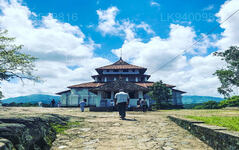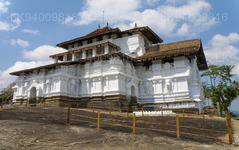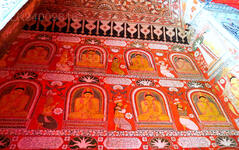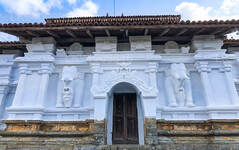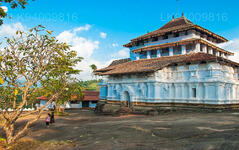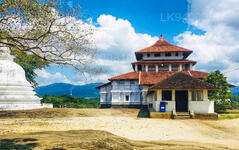
Kandy-stad
Kandy, een pittoreske stad in centraal Sri Lanka, staat bekend om zijn rijke culturele erfgoed, levendige festivals en schilderachtige schoonheid. Gelegen tussen weelderige heuvels, herbergt de stad de Tempel van de Tand, een UNESCO-werelderfgoed, en biedt een fascinerende mix van geschiedenis en natuurlijke pracht.
Lankathilaka Viharaya
Lankathilaka Viharaya in Sri Lanka: The Great Temple of the Kings
Lankatilaka is Buddhist temple of the 14th century in the Hiyarapitiya village, from the Udu Nuwara area of Kandy district in Sri Lanka. This historical temple was built by the Gampola king, King Buwanekabahu the fourth (1341 – 1351AD), in 1344 AD. Gampola was a stronghold on the banks of Mahaveli River.
Lankathilaka Viharaya in Sri Lanka: Architectural Facts
- The temple was designed by the South Indian architect Sthapati Rayar.
- According to the opinions of researchers; the temple combines the design elements of the Polonnaruwa era architecture with that of Dravidian (India) and Indo-Chinese design. At the time of construction the temple was a four storied edifice of eighty feet, built on uneven bedrock using a granite based foundation.
- The temple structure is such that it radiates from the centre in the four cardinal directions, like a cross. Only then ground floor and part of the first floor of the original temple can be seen today, though the temple appears to have three stories from the outside.
- The thick outer walls of the Temple have beautifully sculpted arches and various sculptures making it a unique design of the 14th century.
Lankathilaka Viharaya in Sri Lanka: Sights when entering the Temple
- There are two directions of approach to the temple. One of them has abodes for Buddhist monks at the base of the rock.
- The premises also have many sights such as the huge rice storage bins, known as ‘Atuwa’ by the locals. The stairs begin in the premises of the abodes.
- The other method of approach is from the west of the temple.
- With two ways of approach come two different flights of stairs. One is the original flight built in the 14th century, while the other is more recent; built around 1913. The stairs are cut into the living rock of Pahangalla and provide a climber with beautiful views of the surrounding countryside.
- At the top of the old flight of stairs, the premises of the temple can be entered through a primitive stone door arch, created with three long pieces of rock affixed together.
Lankathilaka Viharaya in Sri Lanka: The Temple
The temple premises have three sectors; the actual temple building, the Dagoba or stupa and finally the Bo tree.
The temple like the flights of stairs has two entrances, leading to two different and disconnected sections in the same building. The main and most important sector is the eastern section, the Buddha Image House. The other is on the west, the the Temples of the Gods.
The Buddha Image House
- The Buddha Image House which is approached from the eastern entrance, right in front of the eastern flight of stairs, and has a Moonstone adorning the ground before the entrance.
- Def. Moonstone: A semi-circular piece of stone which stands at the foot of a flight of steps in most historical Buddhist buildings.
- Two balustrades carved with the Gajasinha or elephant headed lion hybrid design flank the short flight of stairs leading to the entrance archway of the temple.
- The outer archway has a Makara Torana or dragon figure with some unique characteristics that differentiate it from the usual Makara Toranas.
- On the wide inside side walls of the archway display wonderfully preserved paintings of lions. A pair of guardian statues stands close to the wooden door, which has several panels painted with creepers and various designs.
- The inside of the Buddha Image House is an art masterpiece in its entirety with the walls and ceiling completely covered in beautiful paintings dating back to the construction of the temple.
- The pigments used are mostly red, white, yellow and black; with red being the dominant colour possibly because ochre was a pigment that could last the ravages of time.
- The paintings depict the lives of the 24 former Buddhas on the walls, while the ceiling has an abstract flower design.
- The centrepiece of the Buddha Image House is a beautiful golden toned seated Buddha statue. Above the statue is another Makara Torana with sculptures of angels watching over.
Lankathilaka Viharaya in Sri Lanka: Rock Inscriptions
There are inscriptions cut into the rock surface on the temple premises. The inscriptions are both in Sinhala and Tamil, stating that the land was gifted to the Temple by the kings and describing other facilities offered to the temple.
The Lankatilaka Temple is a beautiful cultural heritage of Sri Lanka that has to be visited on a holiday to the country. This temple along with the Embekke temple remains one of the most architecturally advanced structures of the Gampola Kingdom era.
Over het district Kandy
Het district Kandy ligt in de centrale provincie van Sri Lanka. Kandy, een van de zeven werelderfgoedlocaties in Sri Lanka, was ooit de thuisbasis van de Kandyaanse koningen van weleer in de 16e eeuw en een bron voor alle muziek, kunst, ambachten en cultuur in het land. Kandy ligt op ongeveer 129 km van Colombo en is genesteld in een heuvelachtig terrein en alle ogen worden getrokken naar het centrum van de stad, waar het Kandy-meer een charmant kenmerk vormt. Kandy behoudt een grote religieuze betekenis voor Sri Lanka, omdat in deze charmante stad de Dalada Maligawa of "Tempel van de Tand" zich bevindt, waarin de heilige tand van Boeddha goed bewaard wordt. De Koninklijke Botanische Tuin, Peradeniya, ligt ongeveer 5 km ten westen van het stadscentrum in Peradeniya en wordt jaarlijks door 1,2 miljoen mensen bezocht. Het is de grootste botanische tuin op het eiland. De Udawatta Kele (Udawatta-bos) is een beschermd heiligdom in het hart van de stad, net ten noorden van de Tempel van de Tand. Kandy is een stad met een Sinhalese meerderheid; er zijn aanzienlijke gemeenschappen die behoren tot andere etnische groepen, zoals Moren en Tamils. Kandy is, na Colombo, het centrum van de Sri Lankaanse economie. Veel grote bedrijven hebben grote vestigingen in Kandy en veel industrieën, waaronder textiel, meubels, informatietechnologie en sieraden, zijn hier te vinden. Veel landbouwonderzoekscentra bevinden zich in de stad. Het is tevens een bron van alle muziek, kunst, ambachten en cultuur van het land. Op ongeveer 129 km van Colombo ligt Kandy verscholen in een heuvelachtig gebied en alle ogen worden getrokken naar het centrum van de stad, waar het Kandymeer een charmant kenmerk vormt. Kandy heeft een grote religieuze betekenis voor Sri Lanka, omdat in deze charmante stad de Dalada Maligawa, oftewel Tempel van de Tand, is gevestigd, waar de heilige tand van Boeddha goed bewaard wordt.
Over de Centrale Provincie
De Centrale Provincie van Sri Lanka bestaat voornamelijk uit bergachtig terrein. De provincie heeft een oppervlakte van 5.674 km² en een bevolking van 2.421.148. Enkele belangrijke steden zijn Kandy, Gampola (24.730), Nuwara Eliya en Bandarawela. De bevolking is een mix van Singalezen, Tamils en Moren. Zowel de heuvelhoofdstad Kandy als de stad Nuwara Eliya, evenals Sri Pada, liggen in de Centrale Provincie. De provincie produceert een groot deel van de beroemde Ceylonthee, die in de jaren 1860 door de Britten werd geplant nadat een verwoestende ziekte alle koffieplantages in de provincie had vernietigd. De Centrale Provincie trekt veel toeristen, met heuvelstadjes zoals Kandy, Gampola, Hatton en Nuwara Eliya. De Tempeltand, of Dalada Maligawa, is de belangrijkste heilige plaats in de provincie Centrel. Het klimaat is koel en veel gebieden boven de 1500 meter hoogte hebben vaak koude nachten. De westelijke hellingen zijn erg nat, met op sommige plaatsen bijna 7000 mm regen per jaar. De oostelijke hellingen behoren tot de middeldroge zone, omdat ze alleen regen ontvangen van de noordoostelijke moesson. De temperaturen variëren van 24 °C in Kandy tot slechts 16 °C in Nuwara Eliya, dat 1889 m boven zeeniveau ligt. De hoogste bergen van Sri Lanka liggen in de Centrale Provincie. Het terrein is overwegend bergachtig, met diepe valleien die het doorsnijden. De twee belangrijkste berggebieden zijn het Centraal Massief en het Knuckles-gebergte ten oosten van Kandy.

